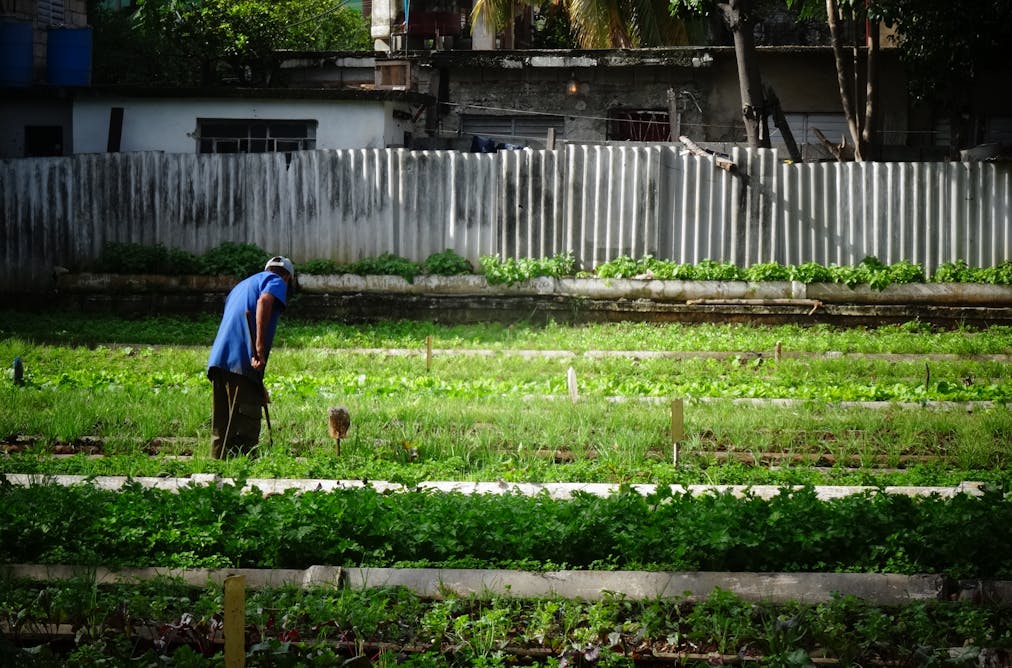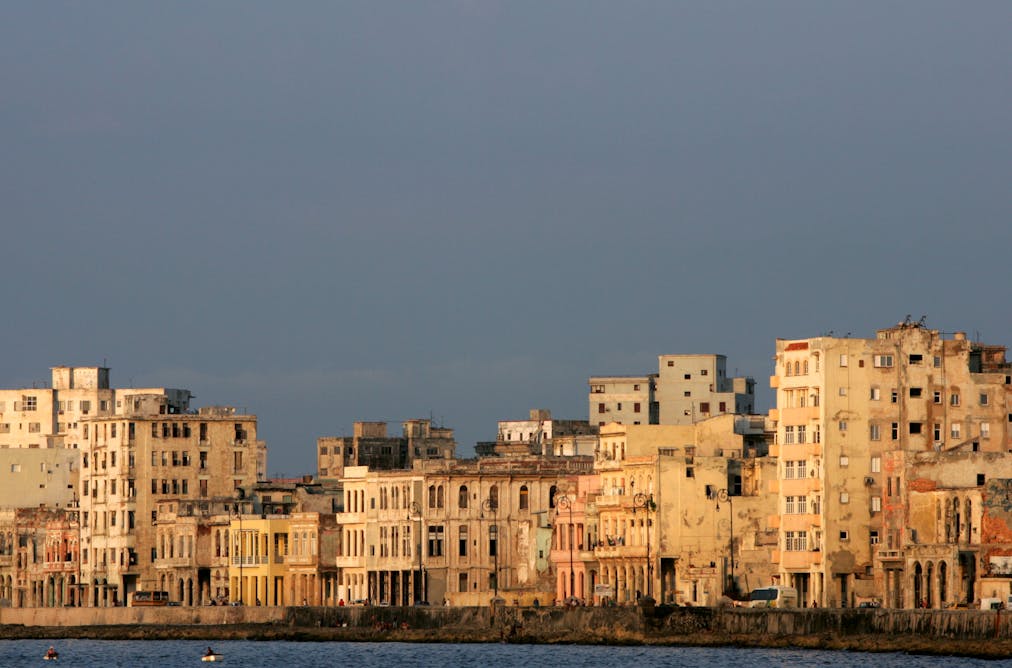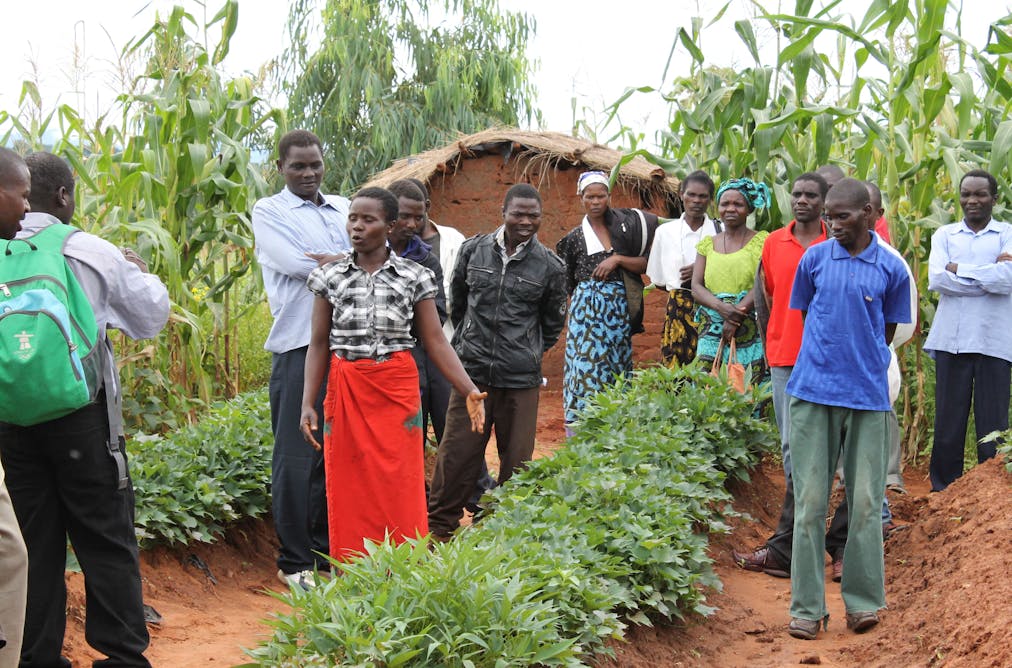Cuban Urban Agriculture as a Strategy for Food Sovereignty
Sinan Koont, Sustainable Urban Agriculture in Cuba (Gainesville, FL: University Press of Florida, 2011), 208 pages, $74.95, hardback.
The agricultural revolution in Cuba has ignited the imaginations of people all over the world. Cuba’s model serves as a foundation for self-sufficiency, resistance to neocolonialist development projects, innovations in agroecology, alternatives to monoculture, and a more environmentally sustainable society. Instead of turning towards austerity measures and making concessions to large international powers during a severe economic downturn, Cubans reorganized food production and worked to gain food sovereignty as a means of subsistence, environmental protection, and national security.1 While these efforts may have been born of economic necessity, they are impressive as they have been developed in opposition to a corporate global food regime.
In Sustainable Urban Agriculture in Cuba, Sinan Koont indicates that most of the global South has lost any semblance of food sovereignty—the ability to be self-sufficient, to practice a more sustainable form of agriculture, and to direct farming toward meeting the needs of people within a country, rather than producing cash crops for export (187). The World Bank and International Monetary Fund imposed structural adjustment programs and free trade agreements on the so-called third world. These policies increased the influence of multinational corporations, such as Monsanto and Cargill, in global food production. They also encouraged large-scale monocultures, whereby food production is specialized by region for international trade. These policies threatened the national food security of countries in several interrelated ways.2
First, economically vulnerable countries are subject to the vagaries of the international marketplace, fluctuating food prices, and heavily subsidized produce from the global North that undermine the ability of the former to compete. Second, in a for-profit economic system, certain crops, like sugarcane, potato, and corn, are planted to produce biofuels, primarily ethanol, instead of food for poor populations. Rich nations that can afford to buy crops for biofuels inflate market prices for food, and when droughts or floods destroy whole harvests, then scarce food still goes to the highest bidder. Third, nations that specialize in cash crops for export must import food, increasing overall insecurity and dependency on trade networks. These nations are more vulnerable to changes in the costs of petroleum, as it influences expenses associated with transportation, fertilizers, pesticides, and the overall price of food. In countries with higher per capita incomes, increasing food costs are an annoyance for many people but not necessarily life threatening. In countries with high rates of poverty, price increases can be devastating. All of the above problems converged during the 2007–2008 food crisis that resulted in riots in Egypt, Haiti, Indonesia, Mexico, and Bangladesh, just to name a few.
People worldwide have been affected by these policies and have fought back. Some nations have taken to task corporations like Monsanto, as in the case of India’s response to genetically modified eggplant, which involved a boycott of Monsanto’s products and demands for the eradication of genetically modified foods.3 There are burgeoning local food movements, even in the United States, that despite numerous challenges attempt to produce food outside the current large-scale agricultural paradigm.4There are also international movements that are working to change agricultural policies and practices. For example, La Vía Campesina is an international movement comprised of peasants, small-scale farmers, and their allies. Their primary goals are to stop neoliberal policies that promote oligopolistic corporate control over agriculture and to promote food sovereignty.
In conjunction with these movements, Cuba has made remarkable strides toward establishing a system of food sovereignty. One of their most notable projects in this regard is their institutionalized and organized effort to expand agroecological practices, or a system of agriculture that is based on ecological principles and environmental concerns. Cuba has largely transformed food production in order to pursue a more sustainable path. These practices are not limited to the countryside.
Cuba is the recognized leader of urban agriculture.5 As Koont highlights, the Cuban National Group for Urban Agriculture defines urban agriculture as the production of food within the urban and peri-urban perimeter, using intensive methods, paying attention to the human-crop-animal-environment interrelationships, and taking advantage of the urban infrastructure with its stable labor force. This results in diversified production of crops and animals throughout the year, based on sustainable practices which allow the recycling of waste materials (29). In 2007, urban agriculture comprised approximately 14.6 percent of agriculture in Cuba. Almost all of urban agriculture is organic.
Cuba’s environmental protections and agricultural innovations have gained considerable recognition. The 2006 Sustainability Index Report, put together by the World Wildlife Fund by combining the United Nations Human Development Index and Ecological Footprint measures (or natural resource use per capita), contends that the only nation in the world that is living sustainably is Cuba.6 The island nation is particularly lauded for its strides in urban food production.7 Sustainable Urban Agriculture in Cuba is the first book to take a comprehensive look at this practice around the entire island.
Koont indicates that the significance of urban agriculture in Cuba is that although Cuba is not completely food self-sufficient, it is the only example the world has of a country that produces most of its food locally, employing agroecological techniques for production. Furthermore, most of the food produced is for local consumption. As a result, Cuba has one of the shortest producer-to-consumer chains in the world. In this book, Koont documents the impressive transformations that have taken place within this nation.
While Cuba imports the majority of its calories and protein, urban agriculture has increased food security and sovereignty in the area of vegetable production. In 2005, Cuba was “importing 60 percent to 70 percent of what it consumes [mostly so-called bulk foods] at an estimated cost of $1.5 billion to $2 billion annually.”8 However, urban agriculture within and around Havana accounts for 60–90 percent of the produce consumed in the city and utilizes about 87,000 acres of land.9 Cubans employ various forms of urban agriculture, including gardens, reforestation projects, and small-scale livestock operations. In 2010, 75 percent of the Cuban population lived in cities—a city is defined as such if the population is in excess of 1,000 persons.10 Thus, urban food production is the most practical and efficient means to supply the population with food.
These transformations did not suddenly materialize. Koont provides a useful overview of the historical circumstances that contributed to changes in food production in Cuba. After the 1959 revolution and the subsequent imposition of the U.S. embargo, Cuba became reliant on the Soviet Union. Cubans used large-scale, industrial, monoculture to produce sugar, which was exchanged for Soviet petroleum and currency. The economy was largely tied to high-yield sugar production. In a vicious cycle, this type of agriculture required importing agrochemical fertilizers, pesticides, herbicides, and oil to run heavy machinery. In 1989, three times more arable land in Cuba was utilized to produce sugar for export than food for national consumption. Most of the Cuban diet came from imported food.11
When the Soviet Union collapsed in the early 1990s, Cubans and their economy suffered greatly. Cubans no longer had access to the inputs required to maintain large-scale agriculture, given how dependent such agriculture is on oil. To make matters worse, the end of trade between the Soviet Bloc and Cuba resulted in a loss of access to food, which reduced Cubans’ protein intake by 30 percent.12The system of agriculture that was in place was not sustainable or organized for self-sufficiency. Cubans refer to the ensuing period of resource scarcity as the Special Period in Peace Time. This period included shortages of food, fuel, and medicine. Faced with food scarcity and malnutrition, Cubans had to revamp their food production systems, which included collectively producing a variety of crops in the most efficient manner possible. Additionally, the necessary mission of Cuban politicians, ecologists, farmers, scientists, biologists, and farm workers was to mend the ecological cycles of interdependence that large-scale, exploitative agriculture destroyed.13
In spite of these hardships, Cuban society was equipped to contend with the ensuing crisis, given the country’s specific commitments and agroecological projects that were already in operation. The Cuban government and leadership worked to provide institutional support to re-direct food production and to enable the development of an extensive urban agricultural project. Governmental policies, following the 1959 revolution, that prioritized extending education, science, and technology served as a springboard for these new agricultural projects. First, the revolutionary government established organizations to address social problems and concerns. These organizations served as supply and distribution networks for food and centers for research that examined farmers’ traditional knowledge, continuing education programs that taught agroecological practices, distribution of technological innovations, and evaluation of existing programs and operations. Second, the government prioritized human resources and capabilities. Thus, the Cuban government invested in human capital by making education more widely available and accessible at all levels. Making use of the organizational infrastructure and investing in the Cuban people made the agroecological transition possible during the economic crisis in the early 1990s.
Koont examines how the early agroecological projects, prior to the Special Period, served as a basis for future development and expansion of the revolutionary transformation of agriculture in Cuba. Science is publicly owned and directed toward furthering human development, rather than capital accumulation. Cuba had the human resources to address food scarcity, given that they had 11 percent of the scientists in Latin America. Scientists were already experimenting with agroecology, in order to take advantage of ecological synergisms, utilizing biodiversity and biological pest control. These efforts were focused on diminishing the need for inputs such as artificial fertilizers and pesticides. Other projects included integrating animals into rotational grazing systems with crops and diversifying with polycultures. Cubans also began recycling sugarcane waste as cattle feed; the cows, in turn, excrete waste that is applied to soil as fertilizer, thereby restoring ecological interdependence. By combining manure with worm castings, Cubans were able to fertilize most of their crops organically without having to import fertilizer from long distances. Their experimentation also included creating urban organopónicos, which were constructed four years before the Soviet collapse. Organopónicos are raised beds of organic materials confined in rectangular walls where plants are grown in areas with poor soil quality. Additionally, personal household plots had long existed within urban areas.14 Altogether these experiments and projects served as the foundation to pursue greater self-sufficiency, a system of urban agriculture, and a more sustainable form of food production.
The pursuit of food sovereignty has yielded many benefits. Urban agriculture has increased food production, employment, environmental recovery and protection, and community building. Perhaps the most impressive strides are in the area of food security. In the early 1990s, during the Special Period, Cubans’ caloric intake decreased to approximately 1,863 calories a day. In the midst of food scarcity, Cuba ramped up food production. Between 1994 and 2006, Cubans increased urban output by a thousand fold, with an annual growth rate of 78 percent a year. In 2001, Cubans cultivated 18,591 hectares of urban land; in 2006, 52,389 hectares were cultivated. As a result of these efforts, the caloric intake for the population averaged 3,356 calories a day in 2005. During the economic crisis, unemployment sharply increased. However, the creation of extensive urban agricultural programs, which included centers of information and education, provided new jobs that subsumed 7 percent of the workforce and provided good wages.
Urban agriculture and reforestation projects also constituted important gains for the environment. Shifting food production away from reliance on fossil fuels and petrochemicals is better for human health and reduces the carbon dioxide emissions associated with food production. Urban reforestation projects provide sinks for air pollution and help beautify cities. Finally, local production of food decreases food miles. It also requires both local producers and consumers. Therefore, community members get to know each other and are responsible for each other through the production and consumption of food.
Sustainable Urban Agriculture in Cuba is a detailed documentation of the agroecological transformation in Cuba. Koont delivers a significant amount of information regarding the mechanics of urban agriculture. He highlights the enabling factors of urban agriculture in Cuba, which are the government’s creation of the organizational infrastructure and their investment in human capital. He also provides an assessment of the results from urban agriculture. The results he discusses are gains made in food production, increased employment, environmental recovery and protection, and community building.
However, the majority of the book reads like a dry technical manual or guide to urban agriculture, something akin to official Cuban government documents. There are many bulleted lists throughout each chapter that outline types of crops grown, strategies, key features of urban agriculture in Cuba, collaborating organizations, evaluation criteria, tons of produce in each province, program objectives, and the lists go on. While the book contains a significant amount of information regarding process, extent, technology, education, and evaluation surrounding urban agriculture in Cuba, it does little in the way of setting up a theoretical framework and thoroughly exploring the significance of Cuba’s model of urban agriculture for the world. The introduction and the final chapter of the book are the two chapters that touch on Cuba’s relevance and implications. In addition, Koont offers minimal critical analysis of the challenges that Cubans still face in their quest for food sovereignty.
Despite these shortcomings, Koont provides a much-needed detailed account of the strides made in Cuban urban agriculture. Cuba’s example has clear implications for food sovereignty and security for the rest of the world. With the very real threat of climate change, potential energy crises, market fluctuations, worldwide droughts, or other economic and environmental problems that may force nations to relocalize food production, this example can serve as a template for future food sovereignty. We can continue to learn from Cuba as they generate new technologies and innovations in organic urban agriculture into the future. In addition, the Cuban example serves as a testament to the potential for a society’s resilience and is worth investigating not just for their innovations, but for inspiration.
Notes
- ↩ Koont defines food sovereignty as “the right of each people to define their own policies concerning agriculture, to protect and regulate their national agricultural production and markets with the aim of sustainable development, to decide to what extent they want to be self-sufficient in food, and to prevent their domestic markets from being inundated with subsidized products from other countries. The emphasis is on local, ecologically sustainable production of culturally appropriate, wholesome, and nutritive foods. Thus conceived, food sovereignty incorporates the concept of food security (adequate food supplies to meet the population’s needs) and even overlaps with national security” (187). Also see Daniel Whittel and Orlando Rey Santos, “Protecting Cuba’s Environment: Efforts to Design and Implement Effective Environmental Laws and Policies in Cuba,” Cuban Studies 37 (2006): 73–103.
- ↩ According to the Food and Agriculture Organization of the United Nations, “food security exists when all people, at all times, have physical and economic access to sufficient, safe and nutritious food to meet their dietary needs and food preferences for an active and healthy life.” See Food and Agriculture Organization of the United Nations, “World Food Summit: Rome Declaration on World Food Security,” November 13, 1996, http://fao.org.
- ↩ “India Blocks Sale of Monsanto GM Crop,” February 10, 2010, http://democracynow.org.
- ↩ Christina Ergas, “A Model of Sustainable Living: Collective Identity in an Urban Ecovillage,” Organization and Environment 23, no. 1 (2010): 32–54; Kathleen Masterson, “U.S. Sees More Female Farmers Cropping Up,” National Public Radio, March 30, 2011, http://npr.org.
- ↩ Adriana Premat, “Moving Between the Plan and the Ground: Shifting Perspectives on Urban Agriculture in Havana, Cuba,” in Luc J. A. Mougeot, ed., Agropolis: The Social, Political and Environmental Dimensions of Urban Agriculture (Sterling, VA: Earthscan and the International Development Research Centre IDRC, 2005), 153–186.
- ↩ Chris Hails, Jonathon Loh, and Steven Goldfinger, Living Planet Report 2006 (Gland, Switzerland: WWF–World Wide Fund For Nature, 2006).
- ↩ Nelso Companioni, et. al., “The Growth of Urban Agriculture,” in Fernando Funes, et. al., eds.,Sustainable Agriculture and Resistance (Oakland, CA: Food First Books, 2002), 220–236; Adriana Premat, “Moving Between the Plan and the Ground”; Rebecca Clausen, “Healing the Rift: Metabolic Restoration in Cuban Agriculture,” Monthly Review 59, no. 2 (2007): 40–52; Diana Raby, “Why Cuba Still Matters,” Monthly Review 60, no. 8 (2009): 1–13; Sinan Koont, “The Urban Agriculture of Havana,” Monthly Review60, no. 8 (2009): 11–20.
- ↩ “Cuba Reports Food Output Up 8.7 Percent in 2011,” February 16, 2012, http://reuters.com.
- ↩ Nelso Companioni, et. al., “The Growth of Urban Agriculture”; Adriana Premat, “Moving Between the Plan and the Ground”; Sinan Koont, “The Urban Agriculture of Havana”; Diana Raby, “Why Cuba Still Matters.”
- ↩ Oficina Nacional de Estadisticas (ONE) República de Cuba. “3.7 – Población Residente y Densidad de Población por Provincias, Según Zonas Urbana y Rural,” 2011, http://one.cu, accessed April 11, 2012.
- ↩ Also see Sinan Koont, “The Urban Agriculture of Havana.”
- ↩ Peter Rosset, “Cuba: A Successful Case Study of Sustainable Agriculture,” in Fred Magdoff, John Bellamy Foster, and Frederick Buttel, eds., Hungry for Profit (New York: Monthly Review Press 2000), 203–213.
- ↩ Also see Rebecca Clausen, “Healing the Rift.”
- ↩ Ibid.
- ↩ Adriana Premat, “Moving Between the Plan and the Ground.”



 Organic farm, Alamar.
Organic farm, Alamar.  Havana market.
Havana market.  Agriculture Secretary Tom Vilsack and Alabama Congresswoman Terri Sewell tour a Havana farmers’ market, November 2015.
Agriculture Secretary Tom Vilsack and Alabama Congresswoman Terri Sewell tour a Havana farmers’ market, November 2015. 







/arc-anglerfish-tgam-prod-tgam.s3.amazonaws.com/public/GOH6A5ZUXBBD7GMU44IGV45NVA)